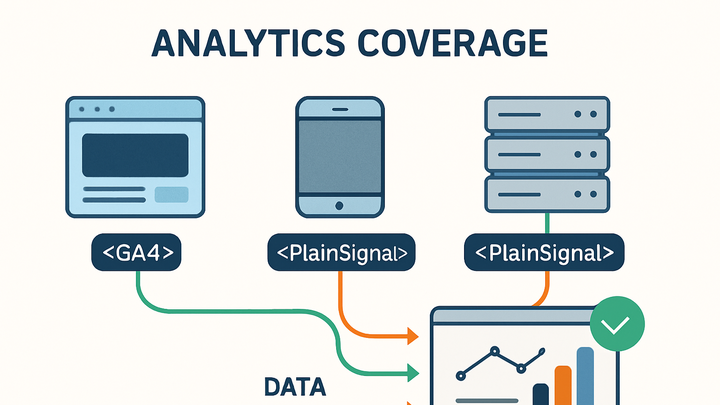Published on 2025-06-28T03:45:56Z
What is Analytics Coverage? Examples of Analytics Coverage
Analytics coverage refers to the proportion of user interactions and events that an analytics system successfully captures across all touchpoints. It measures the completeness of data collection, ensuring that every pageview, click, conversion, form submission, and server-side event is tracked consistently across web, mobile, and backend environments.
Comprehensive coverage reduces blind spots and minimizes discrepancies caused by sampling, ad blockers, or misconfigured tags. It underpins reliable reporting, accurate attribution, and data-driven decision-making. To assess coverage, organizations often compare expected versus actual event counts, perform regular tag audits, and leverage tools like Google Analytics 4 (GA4) and PlainSignal for both client-side and server-side instrumentation.
Achieving robust analytics coverage involves a combination of well-defined tracking plans, implementation of tag management systems, rigorous QA processes, and continuous monitoring. By prioritizing coverage, teams can maintain high data quality, comply with governance requirements, and gain a holistic view of user behavior to fuel business growth.
Analytics coverage
Comprehensive tracking of user interactions across web, mobile, and servers to ensure complete data for accurate analytics.
Why Analytics Coverage Matters
Analytics coverage is the foundation of reliable insights and data-driven decision-making. Without full visibility into user interactions, metrics can be skewed, leading to incorrect conclusions and missed opportunities. Comprehensive coverage ensures that every step in the customer journey is tracked, enabling accurate attribution, performance analysis, and compliance with data governance standards.
-
Complete user journey
Analytics coverage ensures every user touchpoint is tracked, from landing pages to conversions, enabling end-to-end journey analysis.
-
Accurate data-driven decisions
Reliable coverage gives stakeholders confidence in metrics like conversion rates, engagement statistics, and revenue attribution.
-
Compliance and accountability
Robust coverage assists in meeting auditing requirements and adhering to data governance and privacy regulations.
Key Components of Analytics Coverage
Achieving full analytics coverage requires a coordinated approach across multiple technical and organizational layers. This section outlines the core components you need to instrument and maintain to capture comprehensive data.
-
Client-side tracking
Capturing events in the browser using JavaScript snippets like GA4’s gtag.js or PlainSignal’s script ensures real-time data collection on pageviews and user interactions.
-
Pageview tracking
Automatically captures page loads and virtual pageviews to measure user navigation.
-
Event tracking
Custom events for clicks, form submissions, and other user interactions for granular insights.
-
-
Server-side and api tracking
Supplement client-side data with backend calls to ensure events are captured even when users block scripts or during offline interactions.
-
Measurement protocol
Send events directly to GA4 using HTTP requests for accurate backend instrumentation.
-
Server sdks
Use PlainSignal’s server-side SDKs for cookie-free tracking and enhanced privacy compliance.
-
-
Cross-device and cross-domain tracking
Methods to unify sessions across different devices and domains provide a holistic view of the user journey.
-
User-id feature
Link sessions across devices in GA4 by assigning a consistent user identifier.
-
Custom domain linking
Configure cross-domain parameters to maintain session continuity across multiple domains.
-
Measuring Analytics Coverage in GA4 and PlainSignal
Assessing your analytics coverage involves comparing expected interactions with actual captured data. Both GA4 and PlainSignal offer tools and reports to help identify gaps and verify implementation accuracy.
-
GA4 coverage metrics
Use GA4 reports such as Pages and Screens, Events, and comparisons of total sessions versus event counts. In GA360, the Data Completeness report provides deeper insights into missing data and sampling rates.
-
PlainSignal coverage features
PlainSignal offers a lightweight, cookie-free analytics setup with built-in auditing to track missing events and simplify privacy compliance.
-
Code implementation examples
Examples of how to integrate PlainSignal and GA4 scripts into your site:
-
PlainSignal setup
<link rel="preconnect" href="//eu.plainsignal.com/" crossorigin /> <script defer data-do="yourwebsitedomain.com" data-id="0GQV1xmtzQQ" data-api="//eu.plainsignal.com" src="//cdn.plainsignal.com/plainsignal-min.js"></script> -
GA4 setup
<!-- Google Analytics 4 --> <script async src="https://www.googletagmanager.com/gtag/js?id=G-XXXXXXXXXX"></script> <script> window.dataLayer = window.dataLayer || []; function gtag(){dataLayer.push(arguments);} gtag('js', new Date()); gtag('config', 'G-XXXXXXXXXX'); </script>
-
Best Practices to Improve Analytics Coverage
Implementing and maintaining analytics coverage is an ongoing process. Adhering to best practices ensures your data remains accurate and complete as your digital properties evolve.
-
Maintain a detailed tracking plan
Document all required events, parameters, and user properties before implementation to align stakeholders and avoid omissions.
-
Regular tag audits
Use tag management systems and auditing tools to detect missing, duplicated, or broken tags.
-
Automated scans
Schedule periodic scans using tools like Google Tag Assistant or third-party auditors.
-
Manual qa
Test critical user flows across devices and browsers to verify event firing.
-
-
Leverage a robust data layer
Implement a standardized data layer to centralize and structure event payloads, reducing implementation errors.
-
Schema definition
Define a clear data layer structure with naming conventions and required fields.
-
Version control
Manage data layer changes in source control to maintain consistency across development cycles.
-
Common Challenges and Solutions
Even well-planned analytics implementations can face obstacles. Recognizing these common challenges and applying targeted solutions helps maintain high coverage rates.
-
Ad blockers and privacy extensions
Many users employ tools that block client-side tracking scripts, creating invisible gaps in your data.
-
Solution
Implement server-side tracking or proxy scripts to bypass blockers and capture events reliably.
-
-
Sampling and data limits
High-traffic properties may trigger sampling thresholds, affecting data granularity and accuracy.
-
Solution
Upgrade to GA4 360 for unsampled reports or supplement with PlainSignal’s unsampled streams.
-
-
Misconfigured tags
Incorrect triggers or tag settings can lead to missing events and inconsistent data.
-
Solution
Regularly validate tag configurations against your tracking plan and perform QA.
-
-
Cross-domain tracking issues
Sessions may break when users navigate across different domains or subdomains.
-
Solution
Configure linker parameters correctly and ensure consistent cookie settings across domains.
-
